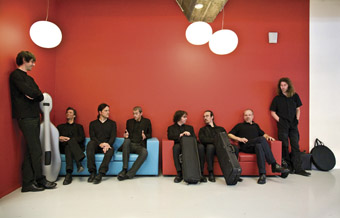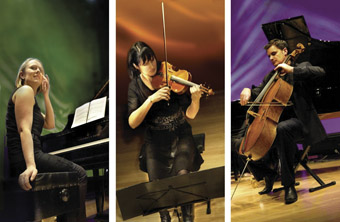epic new music showcase
jeremy eccles: 2010 iscm world new music days, sydney

Spectra ensemble
courtesy ISCM
Spectra ensemble
THE BIGGEST NEW MUSIC EVENT EVER IN AUSTRALIA WILL SPREAD ITS EUTERPEAN TENTACLES AROUND SYDNEY FROM APRIL 30 TO MAY 9. THE 23 CONCERTS FEATURING AT LEAST 82 NEW (OR NEWISH) WORKS PLAYING IN VENUES FROM THE VERBRUGGHEN HALL AND ACROSS WESTERN SYDNEY TO ST FINBAR’S CHURCH, GLENBROOK IN THE LOWER BLUE MOUNTAINS, MAKE UP THIS YEAR’S AURORA FESTIVAL COMBINED WITH THE FIRST EVER VISITATION TO THE SOUTHERN HEMISPHERE BY THE INTERNATIONAL SOCIETY OF CONTEMPORARY MUSIC (ISCM).
This important organisation has been promoting new music, mainly European, since 1922; in 1938, for instance, they put on a concert in London of world premieres consisting of Bartok’s Concerto for Two Pianos, Percussion and Celesta, Britten’s Variations on a Theme of Frank Bridge and Peggy Glanville-Hicks’ Choral Suite! It’s only ever managed to get to America once and that was during the Second World War, though Asia has entered its purview—playing Hong Kong and Yokohama in recent years.
Indeed, the 2010 event was to be in Poland until they recalled that the year might be taken up rather heavily in celebrations of Chopin anniversaries. That left just 18 months for Australia—specifically composer and all-round musical activist, Matthew Hindson—to pull the fat out of the fire. “Matthew’s ears lit up when I first broached the possibility,” recalled John Davis, CEO of the Australian Music Centre and a board member of ISCM since 2002. “‘What an opportunity,’ he enthused, ‘to hold the world’s most prestigious international contemporary music festival’.” Appropriately Davis is now President of the ISCM, chairing meetings that take place during the New Music Days.
Davis had been wanting to host the event in Australia since the late 90s—“and people had been eager to come—even though they recognise that the cultural infrastructure in the Southern Hemisphere just can’t compete with a Donaueschingen or a Gaudeamus Festival. But I could never think of a way of affording it—we have to pay performers, obviously, and host all the delegates and visiting composers; that could be a hundred people. Would they camp on Cockatoo Island? I don’t think so. Fortunately, Hong Kong broke the mould a bit in 2007, cutting back on the size of the whole thing; and then Australia Council International recognised that this wasn’t just a lot of new music but a great way of promoting Australian culture to the world. Plenty of international festival directors (and the President of Croatia, who’s an ISCM delegate) will be here; our performers will be well showcased.”
Performers are headed by Sydney’s Ensemble Offspring—who tackle an amazing three concerts in four days with almost all new scores. “Oh my god, what are we doing?,” says EO’s Damien Ricketson recalling his realisation that the ensemble were about to do a year’s worth of repertoire in one fell swoop. Ricketson, and the directors of other groups such as ABC Classic FM for radiophonic works, the Song Company, Topology, Chronology Arts, the New Zealand Trio and the Goldner Quartet—there’s no Sydney Symphony Orchestra thanks to the short planning period, but the SSO Fellows offer a string band—shared in the selection of their programs with Matthew Hindson from 700 entries world-wide.
“There was a lot of fairly ordinary stuff,” recalls Ricketson, “and somehow it had got through 52 national sections to arrive here. But I’m not embarrassed by anything we’re playing—and I lost a good Thai piece to the New Zealand Trio. Certainly the Australian composers—Matthew tried to get at least one into every concert—will stand up well to the glare of international competition.”

New Zealand Trio
courtesy ISCM
New Zealand Trio
The New Zealanders were a piece of proactivity—lots of composers (including the veteran US-based Annea Lockwood of ‘Piano Burning’ fame) as well as the Trio. John Davis explained that New Zealand had dropped out of the ISCM in recent years and, politically, he was therefore keen to welcome them back with a vengeance; also the Trio was a group with 80 new music commissions under its belt, fully deserving its presence. He’s also inveigled the elite Spectra Ensemble from Belgium to bring music by Bart Van Hecke, Jean-Luc Fafchamps and Bruno Mantovani, a product of a European system which shares the best repertoire around a network of top ensembles. “It was a coup to get them here,” said Davis, “and their sponsorship by the Flanders government and Campbelltown Arts Centre is just fantastic.”
Campbelltown may not be prominently displayed on your mental map of new music in Sydney. But that’s not for want of the centre’s recent efforts. For a start, the ubiquitous Hindson is its music coordinator. Now they say, give the job to a busy man. So it was inevitable to turn to the man who heads the Sydney Conservatorium’s Arts Music Unit, is Chair of the Australia Council’s Music Board (appointed after the ISCM funding had already been granted, he wants to point out), as well as founding the biennial Aurora Festival. Sometimes, he writes music too—which gets commissioned and performed by the likes of the London Philharmonic Orchestra, the Birmingham Royal Ballet and Canadian virtuoso violinist, Lara St John. His composition for ballet, e=mc2, won a South Bank Award for best dance music in the UK in 2009; the first movement, Energy, will be performed by the SSO conducted by Vladimir Ashkenazy on September 2 this year.
Sadly, of course, Hindson has no music in the ISCM New Music Days. But at least 30 other Australian composers do—some familiar, like Ross Edwards, Carl Vine, Peter Sculthorpe, Lisa Lim and Elena Kats-Chernin; others pretty unknown—Katia Beaugeais, Peter McNamara and Daniel Blinkhorn have so far escaped my notice.
There are probably fewer big names from overseas. Elliott Carter and Philip Glass from the US, Rautavaara and Part from the Baltic, Golijov from Argentina are just about it. So we’re going to have to rely on some new names to provide those Britten and Bartok moments. Actually, this is less likely than in previous New Music Days. For the ISCM is in transition. There was a time when a European event would select just the best 12 works submitted from all over the world. But in 2008 they decided that the future lay in the event being more of a showcase for members. This becomes mandatory in 2011, but Matthew Hindson decided to do his best to find music from all member countries as a test of the new system. He managed 38.
“And it wasn’t that hard”, he insisted, “there’s a plethora of young and hungry composers out there, you know.” It’s just possible that knowing who would be struggling through their 700 entries to make the selection could have encouraged composers to “match their choice of music to the buyer,” as John Davis tactfully put it. In other words, Hindson clones may have enjoyed a marginal advantage! Hindson himself is positive: “It was really a pleasant surprise to find that you couldn’t identify the music by the nationality of the composer…South Africans—rhythmic and bright; Greeks—aggressive and noisy! The borders are definitely breaking down. And because this is primarily a chamber music event, I expect the flavour to be intimacy. Maybe it’ll show that the orchestra isn’t the music performance form of the future? Hopefully it will encourage the smaller ISCM sections to take up the baton in that future.”
2010 ISCM New Music Days & Aurora Festival, presenting partners: Sydney Conservatorium of Music, Aurora New Music, ABC Classic FM, Australian Music Centre, New Music Network, Campbelltown Arts Centre, Joan Sutherland Performing Arts Centre and Blacktown Arts Centre, Sydney, April 30-May 9; http://www.worldnewmusicdays.com.au. Eight concerts will be broadcast live on ABC Classic FM and a new ABC digital ‘classical’ music channel will run throughout the event.
RealTime issue #96 April-May 2010 pg. 39






